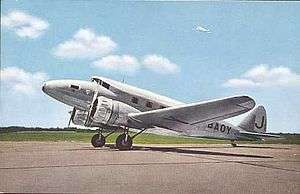Nakajima Ki-34
| Ki-34 | |
|---|---|
 | |
| Nakajima AT-2, civil version of the Ki-34 | |
| Role | Civil airliner/Light military transport aircraft |
| Manufacturer | Nakajima Aircraft Company |
| First flight | 12 September 1936 |
| Introduction | 1937 |
| Primary users | IJA Air Force IJN Air Service Dai Nippon Koku KK Manchukuo National Airways |
| Number built | 351 |
|
| |
The Nakajima Ki-34 was a Japanese light transport of World War II. It was a twin-engine, low-wing monoplane; the undercarriage was of tailwheel type with retractable main units. During the Pacific War, the Allies assigned the type the reporting name Thora.
Design and development
The Ki-34 was originally designed as a civil transport. Nakajima Aircraft Company, which had the license-production rights to the Douglas DC-2, began design work in 1935 on a smaller twin engine airliner for routes which did not have the capacity to justify use of the larger DC-2. The initial design was designated AT-1, and after numerous design iterations, flew as a prototype designated AT-2 on 12 September 1936.[1] The design was all metal, except for the flight control surfaces, which were plywood. The wings used a multi-cell cantilever design. The prototype was fitted with 432 kW (580 hp) Nakajima Kotobuki 2-1 radial engines with fixed pitch wooden propellers, which were replaced in production models with Kotobuki-41 529 kW (710 hp) nine-cylinder radial engines, with variable pitch metal propellers.
Operational history
Civil use (AT-2)
A total of 32 AT-2s were produced for Imperial Japanese Airways (Dai Nippon Koku KK) and Manchukuo National Airways,[2] operating on scheduled routes between Tokyo and Hsinking, Tokyo and Tianjin, and within Manchukuo. These aircraft remained in operational service until the surrender of Japan in August 1945.
Military history (Ki-34 and L1N1)
With a high demand for increased military transport capability after the start of the Second Sino-Japanese War in 1937, the Imperial Japanese Army adapted the AT-2 design for military use by fitting with more powerful Nakajima Ha-1b radial engines and re-designating the aircraft as the Army Type 97 Transport and Ki-34. The initial 19 aircraft were produced by Nakajima Aircraft, and another 299 aircraft were subsequently produced by the Army-affiliated Tachikawa Hikoki K.K.. The final airframe was delivered in 1942.
In operational service, the Ki-34 was used as a utility aircraft for liaison and communications duties, and for paratrooper training and Special Forces operations.
At a later date, some aircraft were transferred to the Imperial Japanese Navy, where they were known as the Navy Type AT-2 Transport or Nakajima L1N1. Several were also transferred to the air force of the Japanese puppet state of Cochinchina in 1942.
Operators
Military operators
Civil operators
- Imperial Japanese Airways (Dai Nippon Koku KK)
- Mongolian People's Army Aviation-Captured and operated more than 12 aircraft since in late September 1945
Specifications (Ki-34)
Data from Japanese Aircraft of the Pacific War;[2] Warbirds Resource Group[3]
General characteristics
- Crew: 3
- Capacity: 8 passengers
- Length: 15.30 m (59 ft 2.25 in)
- Wingspan: 19.81 m (65 ft)
- Height: 4.15 m (13 ft 7.5 in)
- Wing area: 49.2 m² (529.6 ft²)
- Empty weight: 3,500 kg (7,716 lb)
- Loaded weight: 5,250 kg (11,574 lb)
- Powerplant: 2 × Nakajima Kotobuki 2-1 nine cylinder, air-cooled radial engine, 529 kW (710 hp) each
Performance
- Maximum speed: 360 km/h (194 kn, 224 mph)
- Cruise speed: 310 km/h (167 kn, 193 mph)
- Range: 1,200 km (648 nmi, 746 mi)
- Service ceiling: 7,000 m (22,965 ft)
- Wing loading: 106.7 kg/m² (21.9 lb/ft²)
Armament
none
References
- Notes
- ↑ Francillon 1979, p. 204.
- 1 2 Francillon 1979, p. 205.
- ↑ "Warbirds Resource Group". Nakajima Ki-34/L1N1 "Thora". 2010-08-24.
- Bibliography
- Francillon, Ph.D>, René J. Japanese Aircraft of the Pacific War. London: Putnam & Company Ltd., 1979. ISBN 0-370-30251-6.
- Wilson, Stuart (1999). Airliners of the World. Australian Aviation. ISBN 1-875671-44-7.
External links
| Wikimedia Commons has media related to Nakajima AT-2/Ki-34/L1N1. |